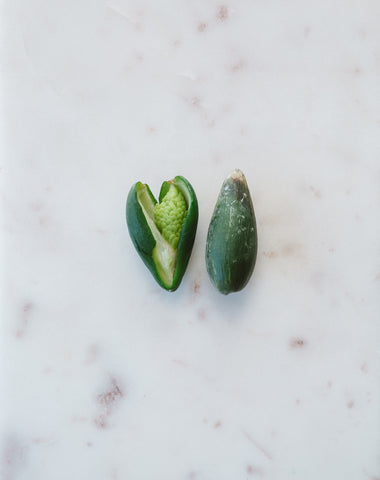Myakka - Pantry of the Desert
The Marsdenia (Bush Pear or Bush Banana) vine grows on Acacias in most parts of arid Australia, from Kalgoorlie to the far east coast. In fact, the name Kalgoorlie was derived from the local indigenous name for this plant – Kurgula. Around Alice Springs it is called Langkwe, and in the Flinders Ranges it is Myakka.
Such an important food plant to the Adnyamathanha people. Young leaves and nectar-rich flowers as well as the beautiful pods. These are a little like sprout cucumbers with a hint of sweet inside. They're great raw or cooked on a fire.

Myakka are really the “pantry of the desert”, as they have four different edible parts. The fruit is shaped like a small avocado and has a wonderful flavour not unlike crunchy snowpeas and zucchini when small, that becomes woody and fibrous when fully grown. The plant exudes a sweet white sticky sap when fruit or leaves are plucked from the stem, and the fruit contains high levels of thiamine. The flowers are quite spectacular and can be eaten straight from the vine, in fruit salad, or as a garnish. The fresh young leaves are great in salads and the yam (or tuber) in the ground at the base of the vine ensures they immediately respond after a bushfire.
This is an important food source for people indigenous to Central Australia and it is also a totemic plant that features in indigenous mythology.

◎ Common Name: Myakka, Bush Pear, Bush Banana, Marsdenia, Silky Pear
◎ Scientific or Latin Name: Marsdenia australis
◎ Comparison: Nashi Pear
◎ Seasonality: Rare
◎ Region: SA Flinders Rangers
◎ Taste Profile: The leaves and flowers are edible and the white fibre of the fruit has a mild flavour, described by some as tasting like snowpea. All plant parts are edible.
◎ Types: Marsdenia is a genus of about 60 species, 18 of which occur in Australia. They are generally climbers or small to medium shrubs.
Benefits
- Exceptionally rich in thiamine, they yield up to 2900 micrograms per 100 grams, more than ten times that of any cultivated food.
- The fruit contains high levels of thiamine.
- An extremely useful and utilised plant, all parts are edible.
Traditional Aboriginal Food and Uses
Aboriginal & Traditional
One of the significant bush food for the Aboriginal people of Australia, the food is often depicted in current Aboriginal art, especially paintings about 'bush tucker', as well as 'Bush Banana Dreaming' paintings.
All parts of the bush banana plant are still eaten in the desert region by indigenous communities today.
Western & Modern
Every part of the bush banana is used as a food source. The flowers are edible and have a slightly sweet taste. The young green fruit are usually eaten raw and have a pleasant flavour somewhat reminiscent of lucerne. The thick outer rind of the green fruit contains a white latex-like substance which can make the lips tingle unpleasantly if too many raw fruit are eaten. As the fruit matures and the seeds and their plumes develop, the whole fruit is usually cooked and eaten whole. The white root of the plant can also be consumed raw or cooked. If the fruit is over-mature then the seeds are often discarded and just the thick outer rind is eaten.
It is being successfully cultivated in South Australia’s Riverland so a continuous supply is very much a reality.
The Myakka fruit are a wonderful green vegetable, boiled or microwaved with butter, lemon juice and mountain pepper, or sliced raw into salads, stir fried or used whole in casseroles.
Medicinal
While the Myakka is an incredibly versatile indigenous food, and all parts can be consumed, there are no known medicinal uses for this plant.
◎
Note: The term 'Bush Tucker' and 'Bush Food' are not Warndu's preferred terms for Australian Native Ingredients or Australian Botanicals.
Images: © Luisa Brimble
